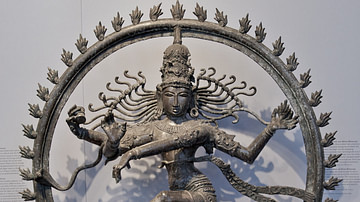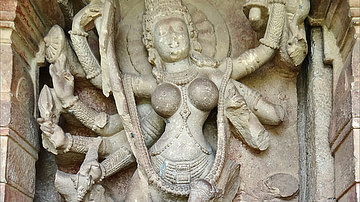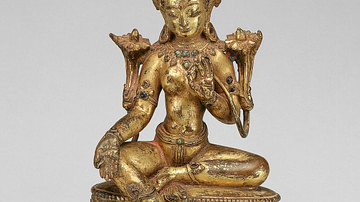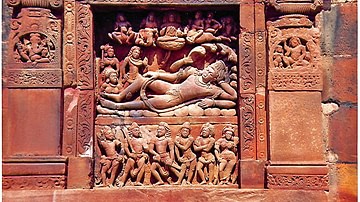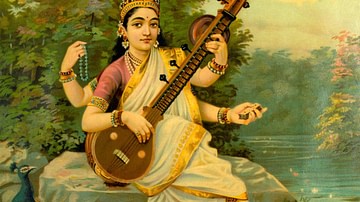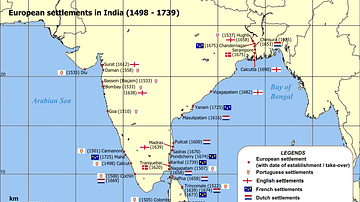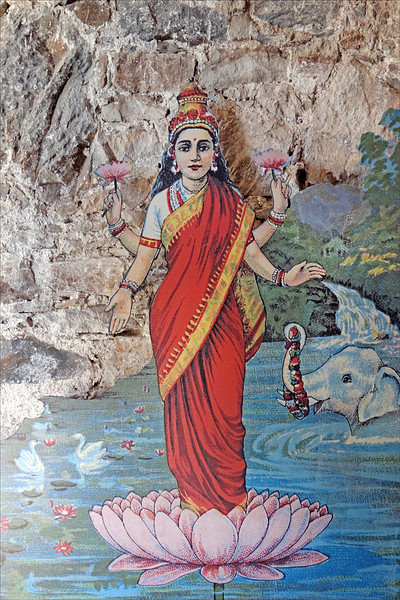
Lakshmi (or Laksmi) is the Hindu goddess of wealth, good fortune, youth, and beauty. She is the wife of the great god Vishnu and the pair is often worshipped in tandem as Lakshmi-Narayana. Just as her husband has many avatars when he descends to earth so too Lakshmi takes on different forms:
- Sita, wife of lord Rama,
- Dharani, wife of Parashurama,
- Queen Rukmini, wife of Krishna
- Padma, wife of Hari
Lakshmi may also be called Lokamata, 'mother of the world' and Lola, meaning fickle, in reference to her seemingly haphazard dispensation of good fortune.
Birth & Associations
In the Mahabharata, Lakshmi was born from the stirring of the primeval milky ocean by the gods and demons. Following the intervention of Brahma and Vishnu, Lakshmi miraculously appeared from this sea of clarified butter clothed all in white and radiating youth and beauty. For this reason, the goddess is sometimes called Ksirabdhitanaya, 'daughter of the sea of milk'. Lakshmi immediately gave herself to Vishnu's protection and for this reason, she is said to dwell on Vishnu's chest giving rise to one of the god's alternative names, Shrinivas meaning 'the dwelling place of Sri'. Sri (Shri) means prosperity and is another of Lakshmi's many names. According to the Harivamsa Lakshmi is the mother of Kama, the god of love and so provides an interesting parallel to the Greek goddess Aphrodite and her son Eros, the former also born from a foaming sea.
The goddess is particularly associated with the lotus flower and is sometimes referred to simply as the Lotus Goddess. In this guise, she is a member of the Buddhist pantheon too. The goddess has no temples built in her name but she is particularly worshipped in one of Hinduism's most evocative celebrations, the annual Diwali or 'Festival of Lights', held every October-November.
In one myth Lakshmi got a little fed up with her husband and went to live with the royal family of King Akasha Raja in southern India. There, now calling herself Padmavati, she was eventually found by a distraught Vishnu, himself in the guise of Shrinivas. Brahma and Shiva had actually conspired for the two to meet and they, of course, fell in love and married in a lavish ceremony (again) which is still commemorated today in the town of Tirupati in southern India.
How is Lakshmi Represented in Art?
In art, Lakshmi is often represented either standing or seated on a large lotus flower and holding a water pot and single lotus flower in her hands, always either blue or pink. With her other two hands she typically gives a sign of blessing and showers coins on her loyal followers. The goddess usually wears a pink sari and is accompanied by various traditional symbols of good luck such as painted elephants decorated with garlands of flowers, often spraying water from their trunks. Lakshmi regularly appears alongside her husband Vishnu in temple decorative sculpture, for example, massaging his feet with lotus flowers or riding his gigantic man-bird vehicle Garuda.
In Cambodian art, Lakshmi is more typically portrayed as a single-figure statue, standing, wearing a tiara and holding a lotus bud. In Cham art the goddess is always seated and besides the lotus bud can also hold a conch shell. Finally, in Javanese art Lakshmi holds a grain of rice as there she is regarded as the goddess of this important food.

